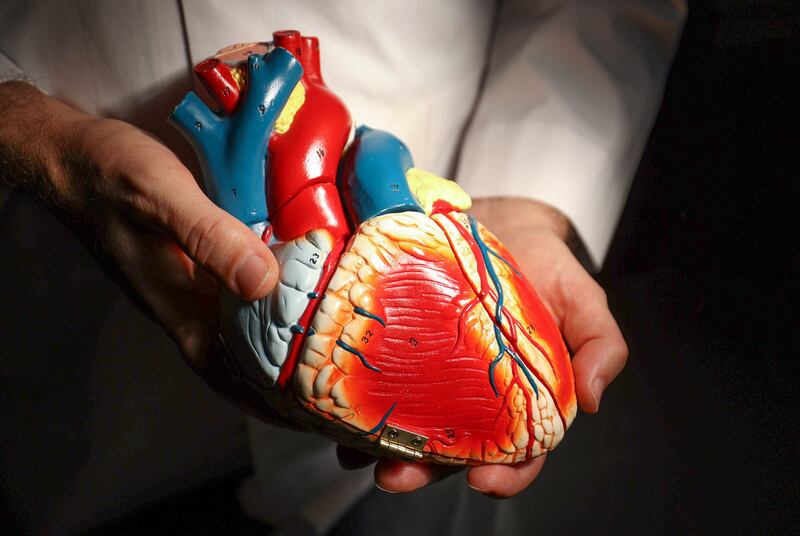Could a phenomenon known as commotio cordis, in which the heart stops after suffering blunt force trauma that disrupts its electrical system, be the cause of Damar Hamlin’s sudden collapse during the Buffalo Bills game with the Cincinnati Bengals?
Hamlin, 24, collapsed after tackling Bengals wide receiver Tee Higgins. After the play, Hamlin stood but suddenly fell to the ground. Video shows he took a hard blow to the chest during the collision. The Bills safety remains critically ill at a Cincinnati hospital.
University of Utah Health cardiac electrophysiologist Dr. T. Jared Bunch said multiple factors must line up in commotio cordis, Latin for “agitation of the heart.”
“It’s the right amount of force in the right location within a few milliseconds, 10 to 20 milliseconds. Everything has to align perfectly,” said Bunch, who specializes in diagnosing and treating problems with the heart’s electrical system.
Animal experiments that replicate this phenomenon “just show this vulnerability that the mammalian heart has at the perfect time, the perfect force and the perfect velocity during its recovery. It’s fortunate that it takes so many things aligning that we don’t see it more often,” he said.
Commotio cordis occurs more often in young males ages 10-18 who are struck in the chest by baseballs, hockey pucks or lacrosse balls, resulting in ventricular fibrillation causing sudden cardiac arrest in an otherwise structurally normal heart.
In 2005, an 18-year-old BYU freshman died after going into cardiac arrest during a hockey game in Provo. Jaxon Logan was struck in the ribs with a puck while diving to block a slap shot fired by an opponent. He came out of the game, collapsed and despite efforts to revive him, he was later pronounced dead at a Utah County hospital, according to a Deseret News report at the time.

In Hamlin’s case, he received immediate medical attention. He was resuscitated at Paycor Stadium before being transported to the University of Cincinnati Medical Center, where he remains in the intensive care unit but was showing “remarkable improvement,” according to a statement by the Bills organization on Thursday.
Perhaps most bewildering to observers was that Hamlin, after tackling Higgins, stood up and then fell backward, making no effort to break his fall.
Bunch said Hamlin is an elite athlete who likely was aided by adrenaline in the moments after the collision between the two athletes.
Typically, an unstable heart rhythm makes it difficult to maintain blood pressure, he said.
“There’s a lot of adrenaline going on in that play. It’s a game that has playoff implications. It’s early in the game, making a tackle, so there’s also a lot of adrenaline on board and that helps us maintain our blood pressure temporarily. So some of that may have been a reflection of his ability to compensate for a few minutes,” he said.
Since commotio cordis can be triggered by being struck in the chest by a projectile such as a hard ball or hockey puck, some studies have focused on the effectiveness of protective equipment such as padded chest guards.
Defensive lacrosse and hockey players can also be coached to avoid using their chests to block a ball or puck at the goal.
CNN reported Wednesday that the NFL is investigating every possible cause behind Hamlin’s cardiac arrest.
The NFL’s chief medical officer Dr. Allen Sills said it is a diagnosis of exclusion. Commotio cordis might be the diagnosis if doctors don’t find any other causes, Sills said.
Other possibilities could include a previously undiagnosed heart condition such as hypertrophic cardiomyopathy or Long QT Syndrome or a structural problem with the heart.
Bunch said given these high profile events, parents ask him “all the time” whether they should allow their children to participate in sports in which commotio cordis could occur. Questions also come from parents whose children have inherited cardiac conditions.
“Our tendency is, if it’s at all possible, to let them play because of the numerous benefits of athletic competition for children. Ten to 20 years ago, we were more restrictive. We’ve learned how to manage these conditions and these risk profiles better,” he said.
There are some conditions in which significant exertion and aerobic activity are not allowed “but the vast majority, when carefully managed, can return to play and be active,” Bunch said.
Families must decide for themselves but they need to consider the evolving nature of elite sports, he said.
“We keep making people bigger, faster and stronger. But ultimately, they’re still a biologic human and there’s vulnerabilities,” Bunch said.
“From the heart standpoint, we tend to advocate as much as we can to allow them to play.”


